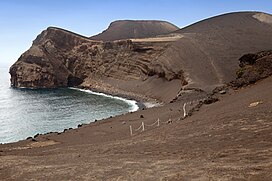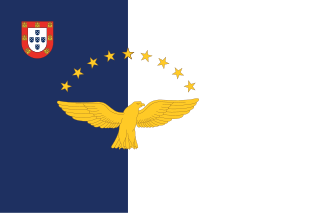
The Azores, officially the Autonomous Region of the Azores, is one of the two autonomous regions of Portugal. It is an archipelago composed of nine volcanic islands in the Macaronesia region of the North Atlantic Ocean, about 1,400 km (870 mi) west of Lisbon, about 1,500 km (930 mi) northwest of Morocco, and about 1,930 km (1,200 mi) southeast of Newfoundland, Canada.
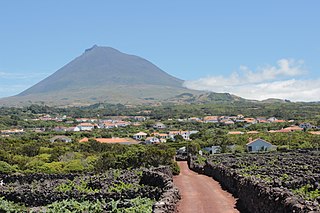
Pico Island is an island in the Central Group of the Portuguese Azores. The landscape features an eponymous volcano, Ponta do Pico, which is the highest mountain in Portugal, the Azores, and the highest elevation of the Mid-Atlantic Ridge. In the tradition of the Portuguese poet, Raul Brandão, Pico is referred to as the Ilha Preta, for its black volcanic soils, which nourish its UNESCO-designated vineyards that once allowed the development of the island's economy. Pico is the second largest and, geologically speaking, the most recently formed island of the Azores, being around 300,000 years old.

Horta is a municipality and city in the Portuguese archipelago of the Azores encompassing the island of Faial. The population in 2011 was 15,038 in an area of 173.06 square kilometres (66.82 sq mi) The city of Horta itself has a population of about 7,000.

Faial Island, also known as Fayal Island, is a Portuguese island of the Central Group or Grupo Central of the Azores, in the Atlantic Ocean.

Capelo is a freguesia in the municipality of Horta on the island of Faial in the Azorean archipelago. The population in 2011 was 486, in an area of 26.64 km2. Capelo may be considered the westernmost settlement of Eurasia, if Fajã Grande, on Flores Island, is considered part of North America, for it sits on the North American Plate.
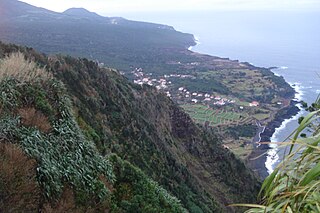
Praia do Norte is a civil parish of the municipality of Horta, located along the northern coast between Cedros and Capelo, on the Portuguese island of Faial, in the archipelago of the Azores. The population in 2011 was 250, in an area of 13.85 square kilometres (5.35 sq mi). It is the least populous parish on the island, reached along the Estrada Regional E.R.1-1ª regional roadway from the urban centre of Horta. It contains the localities Cerca, Fajã and Praia do Norte.
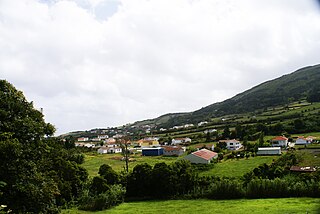
Ribeirinha is a freguesia in the municipality of Horta in the Portuguese archipelago of the Azores. The population in 2011 was 427, in an area of 12.26 km2. It contains the localities Canadinha, Chã da Cruz, Espalhafatos, Lomba dos Espalhafatos and Rua da Igreja.
The following is a list of notable natural disasters that have affected the Azores:

Mount Pico is a currently dormant stratovolcano located on Pico Island, in the mid-Atlantic archipelago of the Azores. It is the highest mountain in Portugal, at 2,351 metres (7,713 ft) above sea level, and is one of the highest Atlantic mountains; it is more than twice the elevation of any other peak in the Azores. It has been a designated nature reserve since 1972.

Vulcão da Urzelina is a volcano near the civil parish of Urzelina, Velas municipality, São Jorge Island, Azores.

Volcanic Complex of Topo is a complex of scoria cones and volcanic structures, located near the village Topo in the southeastern part of the island of São Jorge, in the Portuguese archipelago of the Azores.

The hydrothermal vents and seamounts of the Azores are a series of Atlantic seamounts and hydrothermal vents that are part of the Mid-Atlantic Ridge system, giving rise to the archipelago and bathymetric region of the Azores. These geological structures, formed from masses of basalt, are of a geomorphological interest due to their rich deposits of ore. In addition it fosters a rich ecosystem of diverse subaquatic plant and animal life. There are food chains within this environment, for example, that are purely chemosynthetic, and do not need sunlight for photosynthesis.

The Nature Park of Faial, or simply Faial Nature Park (PNF), developed from the intention of better managing the protected areas of the island of Faial, and was instituted by the Secretaria Regional do Ambiente e do Mar of the Autonomous Regional Government of the Azores.

The Lighthouse of Ponta dos Capelinhos, or alternately Lighthouse of Capelinhos, is a former beacon/lighthouse located along the coastal peninsula of Ponta dos Capelinhos and Costa Nau, in the civil parish of Capelo, on the island of Faial in the Portuguese archipelago of the Azores. Constructed in the late 19th century, it is an iconic symbol on the island, for the eruption of Capelinhos volcano, which occurred in 1957–58.

The Azores Geopark is a network of 121 geographically-dispersed sites of geographic heritage and marine areas that covers the nine volcanic islands of the archipelago of the Azores. This network is managed by the Azores Geopark Association, a non-profit association, with its headquarters in Horta on the island of Faial, established 19 May 2010. It is part of the European Geoparks Network and the UNESCO Global Geoparks Network. The Association's mission is to ensure the geological conservation, environmental education and sustainable development, while promoting the well-being of the population and a respect for the environment.
The Congro Volcanic Fissural System is a system of scoria cones that build up the central region of the island of São Miguel. This volcano is very young with most of it only 5000 years old.

Sete Cidades Massif is a stratovolcanic complex, referring to a polygenetic volcano and caldera, located in western part of the island of São Miguel, in the Portuguese archipelago of the Azores. More recognizable for the Lagoa das Sete Cidades at its centre, the volcanic complex includes centuries of geomorphological structures that include lava domes, cones, lava flows and maar geomorphology that have marked its history.
The 1964 Rosais earthquake was a series of seismic swarms occurring in February 1964, leading to two major earthquakes on 15 and 21 February, resulting in the destruction of most of the habitable dwellings on the western part of the island of São Jorge, in the archipelago of the Azores. The event resulted in the evacuation of approximately 5,000 residents from that island to Terceira, Pico and Faial.

The Lighthouse of Vale Formoso is a beacon/lighthouse located along the southwestern cliffs of the civil parish of Capelo, in the municipality of Horta, on the Portuguese island of Faial, in the archipelago of the Azores.
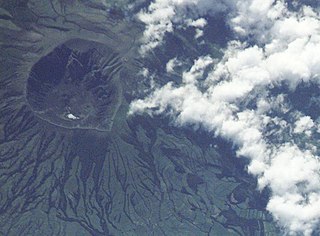
The Caldeira Volcano is the highest mountain, massive stratovolcano and the largest geomorphological structure that forms the island of Faial. The mountain's highest point, Cabeço Gordo, reaches 1,043 metres (3,422 ft) above sea level. One of the most notable features of this volcano is its two kilometer wide caldera, that is 400 m (1,300 ft) in depth below the crater rim.
